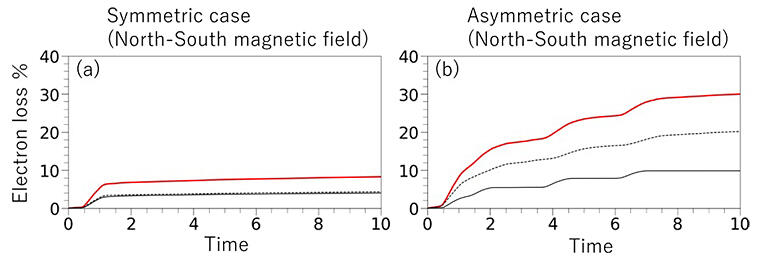A research group including Associate Professor Mitsunori Ozaki and Professor Satoshi Yagitani of the School of Electrical, Information and Communication Engineering, College of Science and Engineering at Kanazawa University, and Professor Yoshiharu Omura of the Research Institute for Sustainable Humanosphere at Kyoto University, discovered that the peculiar magnetic field structure of Mercury enhances electromagnetic waves around the planet, which then efficiently cause high-energetic electrons to precipitate on the planet surface. This result was obtained through computer simulations that evaluated interactions between plasma and electromagnetic waves. Descending electrons may have chemically interacted with the planet's minerals, forming water in Mercury's permanent shadow. The results were published in the international journal Geophysical Research Letters on October 31.

Provided by Kanazawa University
Craters in the north and south polar regions of scorching Mercury, which is closest to the sun, have areas of permanent shadow (temperature is below −170℃) where no light from the sun falls. Although the presence of ice has been reported in such regions, the formation mechanism of ice (water) remains unknown. Because the Moon does not have a global magnetic field, the high-speed stream of plasma (solar wind) blowing from the Sun collides with the lunar surface, which is thought to cause "in-situ water formation." In this case, water is formed by a chemical interaction between the protons of the solar wind and oxygen ions in lunar rocks.
In contrast, Mercury has its own magnetic field, and the magnetosphere prevents the solar wind from directly colliding with the planet surface due to the force of this magnetic field. Therefore, for "in-situ water formation" to occur, an event other than a direct collision with the solar wind is required.
So far, the first observation of electromagnetic waves in Mercury has been made by the Japanese and European Mercury exploration mission "BepiColombo" in 2021 and 22, which confirmed the presence of whistler mode waves (a type of electromagnetic wave) within Mercury's magnetosphere. Whistler waves efficiently scatter high-energetic electrons and are responsible for unusual auroral lighting observed on Earth.
The research group therefore used computer simulations to evaluate the effects of electron scattering caused by Mercury's whistler mode waves. Simulation was conducted using a code developed by Omura. It can evaluate the mutual influence of plasma movement along magnetic field lines and electromagnetic waves. In particular, the effects of Mercury's magnetic field lines that have an asymmetric north-south structure were studied in detail.
The results show that by considering a north-south asymmetric structure, the temperature anisotropy of electrons on the southern hemisphere side increases, and this peculiar magnetic field line structure promotes the growth of whistler mode waves. Additionally, this causes 3.8 times more high-energetic electrons to fall onto the planet's polar surfaces than if the magnetic field was assumed to have a symmetric structure.
The number of precipitating electrons exhibits a variation of the order of tens of milliseconds, similar to the intensity variation of whistler mode waves, indicating that a nonlinear plasma scattering mechanism due to whistler mode waves is responsible for efficient electron precipitation. The high-energetic electron precipitation mechanism revealed in this study is expected to directly affect water formation on Mercury surface and indirectly influence water formation due to transport effects even if water flows out into space after its formation.
Ozaki said, "Simulation results conducted prior to the observations indicated that electromagnetic activity around Mercury enhances electron precipitation, which is expected to affect water formation on Mercury. I'm looking forward to continuing this research even more, considering the fact that we will carry out this verification using data from the comprehensive observations of Mercury's electromagnetic waves and plasma from 2026 onward under the BepiColombo project!"
Journal Information
Publication: Geophysical Research Letters
Title: Implications of Asymmetric Loss Cone Distribution on Whistler-Driven Electron Precipitation at Mercury
DOI: 10.1029/2024GL111744
This article has been translated by JST with permission from The Science News Ltd. (https://sci-news.co.jp/). Unauthorized reproduction of the article and photographs is prohibited.




